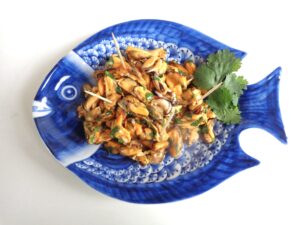
Spicy cocktail mussels
This dish emanates from Sète, a charming Mediterranean port in southwest France. It is generally served during cocktail hour, accompanied by a chilled white or rosé, and is often presented in little glasses, known here as verrines. Alternatively, you can present the mussels on a pretty plate with one toothpick per guest.
For best results, be sure your mussels are ultrafresh, and cook them just until they’ve opened to ensure that they are plump and tender — overcooking will dry and shrivel them.
To complete the dish, the cooked mussels are removed from their shells and bathed in a sauce of garlic, hot pepper and fresh herbs. Parsley is traditional, but I have found that basil or cilantro (a personal favorite) also complement the mussels well.
As for the hot pepper, there are three possibilities. You can use half of a bird’s-eye pepper (or more for extra heat), a dried cayenne pepper or — if you can find it — piment d’espelette, a mild form of powdered red pepper that is widely used in southwest France.
 The quantities below will serve three people in verrines or four on a platter.
The quantities below will serve three people in verrines or four on a platter.
1 quart (1 liter) mussels
1 clove garlic
1/2 bird’s-eye pepper, 1 cayenne pepper or 1/4 tsp. piment d’espelette (see above)
1 tbsp. olive oil
1 tbsp. finely minced fresh herbs: parsley, basil or cilantro
When you bring the mussels home, remove any packaging and transfer them to a glass and ceramic bowl. Refrigerate until ready to start the recipe (up to 24 hours).
Clean the mussels: Immerse them in a bowl of cold water. One by one, find and remove the beards — these are the algae-like hairs that protrude from the straighter edge of the mussel shell. As you go, transfer the mussels to a colander. Rinse well when finished.
Transfer the mussels to a large pot. For this dish, they are cooked ‘à cru‘ — directly over the heat, with no liquid, oil or butter. Cover the pot and turn the heat up high. The mussels will open within 3-5 minutes. To help them open at an even rhythm, shake the pot from time to time or give them a stir. When all the mussels have opened, turn off the heat.
When the mussels have cooled enough for easy handling, remove them from their shells and place in a clean bowl. Place a sieve over the bowl, pour the shells and cooking juices through and discard the shells. The strained juices will help the mussels stay plump. Wait about half an hour before continuing.
Make the sauce while the mussels are resting. Traditionally, this sauce is made in a mortar and pestle, but you can also make it in a blender or by hand.
Peel the garlic and crush in a mortar or put it through a press into a blender or bowl.
Add the pepper as follows: If using a half a bird’s-eye pepper, remove all the seeds, mince finely and add. If using cayenne, crush the dried pepper and add. If using piment d’espelette, simply add. Blend well with the garlic.
Blend or stir in the olive oil little by little. Add the fresh herbs.
Now pour the mussels and their juices through a sieve, this time discarding the juices. Shake the sieve to remove as much liquid as possible. Transfer the mussels a clean bowl and add the garlic mixture. Stir well to coat the mussels with the sauce.
Refrigerate for at least one hour to allow the flavors to blend. Half an hour before serving, remove from the fridge — the mussels will be tastier at room temperature.
Serve in small glasses (verrines) with a small fork or spoon, or a toothpick. Or serve on a pretty plate with as many toothpicks as there are guests. Serves 3-4.




